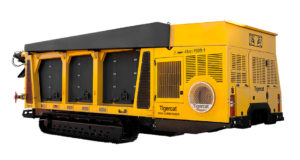Can Closure Trend Help Open Forest Bioeconomy Opportunity?
Article by Dan Shell, Managing Editor, Timber Harvesting May/June 2024
Perhaps he’s the hardest working man in show business, but soon after keynote speaking at the Wood Bioenergy Conference & Expo in Atlanta, here was American Loggers Council (ALC) Executive Director Scott Dane on Fox News Business with Stuart Varney citing an ALC report showing that during the past 15 months, roughly 50 forest products facilities around the country have announced closures, curtailments or reductions that have eliminated 10,000 jobs.
Of course, during that same time, multiple mill projects have been announced, both new and expansions. But it’s not as simple as swapping out old board feet for new, Dane says. “A mill opening 150 miles from where a mill closed, or that uses different species and wood specifications, does not equate to a net zero exchange. So, to merely compare lost production volume to new or expanding production outputs and ignore the geographic displacements or different timber specifications is not reflective of the direct losses and impacts,” he exclaims. In economic development, it’s always easier to maintain an economic base rather than replace it. Supporting existing forest products markets should be the first objective, he adds.
This brings us to the case of Pyramid Mountain Lumber in Seeley Lake, Mont., the most recent Western U.S. mill closure announcement. Mill owners cited market conditions, primarily, but also labor problems related to affordable housing. It’s one less log yard for the state’s loggers to fill and just as important, one less facility that’s part of the forest health solution and providing a key outlet for material generated by utilizing small logs in the mill and biomass material in its boiler.
Is Montana entering dangerous territory here? The cautionary tale is Arizona, where forest products infrastructure was allowed to wither away as a result of federal timber sale program restrictions. Now the state is in dire need of conversion facilities to bolster forest health efforts that include a huge backlog of approved projects hampered by the lack of mills—and a shortage of contractors to deliver the wood.
Already, news reports covering the Pyramid Mountain announcement have comments from regional land managers that despite funding for projects there’s one less market to handle the material, and it’s especially tough for projects that rely on mill receipts to fund future forest health work.
Meanwhile, on the other side of the Rockies many loggers are facing challenges as the pulp and paper industry undergoes wrenching changes that are resulting in more recycled fiber utilization and less roundwood and chips. According to Dane’s report, since January 2023 the following Eastern U.S. states have seen pulp-paper facility closures: North and South Carolina, Maine, Georgia, Indiana, Michigan, New York, Arkansas, Texas and Florida.
In many cases, these are facilities that take in millions of tons of fiber, with logging rates only viable for logging contractors at high production volumes. Many contractors now working the procurement zones of those facilities have nowhere else to turn, with lots of logs (and maybe loggers) looking for a new home.
Silver Lining?
In his vision to transition the forest industry to the future, Dane sees (and I agree) the logging industry playing a key role in forest health issues—and also sustainable energy. “The forest-based bioeconomy can help replace the lost legacy markets and transition to renewable fuels, renewable energy, renewable chemicals, renewable industrial wood pellets, renewable building products, all produced from renewable timber,” the ALC report states.
The vision Dane promotes includes beefing up the U.S. Renewable Fuel Standard in mandate and incentive that prioritizes the utilization of biomass for a variety of applications. An industry benefiting from EU energy policies such as U.S. pellet producers and the contractors feeding the plants, for example, should be lobbying to create the same policies in the U.S. Yet doing so is going to require some heavy lifting, especially among political constituencies that have traditionally been opposed to renewable energy in general, much less actively promoting it.
“The U.S. is out of step with the accepted global science of biomass feedstock for energy production to address climate change,” Dane says in the ALC report. “The U.S. needs to develop a domestic bioeconomy market and policy just as the rest of the developed world has.” Developing a bioeconomy would bring more emphasis on biomass and the technology to convert it. And here’s where the green economy solidifying the logger’s role within it really kicks in: While plenty of biomass and pellets will still be burned old school style in boilers fitted with latest emissions control technology, wood in the form of small diameter material and biomass will increasingly be converted through gasification and torrefaction, creating new carbon-dense products (and energy!) and supercharging demand for materials that are truly sustainable. And the logging industry is one of the building blocks allowing it to happen.
Forest-based biomass feedstock can provide the input material for renewable natural gas, hydrogen, Sustainable Aviation Fuel, electricity, coal conversion, and steel / concrete production. As a speaker at the recent Wood Bioenergy Conference & Expo (see page 22) noted, what other kind of material provides feedstock to produce sustainable aviation fuel (SAF) in a low-emissions process itself that yields not only an advanced biofuel but also a highly carbon concentrated residual that’s useful in a variety of applications?
Embracing policies that promote the bioeconomy sector’s growth will demonstrate a commitment to revitalizing America’s rural economy, communities, and ailing forest health, while developing and transitioning into renewable forest-based bio-products, the report concludes.
Latest News
Canfor Announces Transition; Yurkovich Becomes CEO
Canfor Announces Transition; Yurkovich Becomes CEO John Baird, Chairman of the Canfor Corp. Board of Directors, announced today that Don Kayne, President and Chief Executive Officer, plans to retire...
New From Tigercat: 6040 Carbonizer
Tigercat Industries has announced the official release of its 6040 carbonizer—which replaces the 6050 carbonator that Tigercat marketed for a brief time after acquiring the product through the purchase of ROI in 2019. The mobile onsite wood conversion system is once again available after a comprehensive, ground-up redesign.
WANT MORE CONTENT?
Spanning seven decades since its inception in 1952, Timber Harvesting highlights innovative and successful logging operations across the U.S. and around the world. Timber Harvesting also emphasizes new technology and provides the best marketing vehicle for the industry’s suppliers to reach the largest number of loggers in North America and beyond.
Call Us: 800.669.5613


